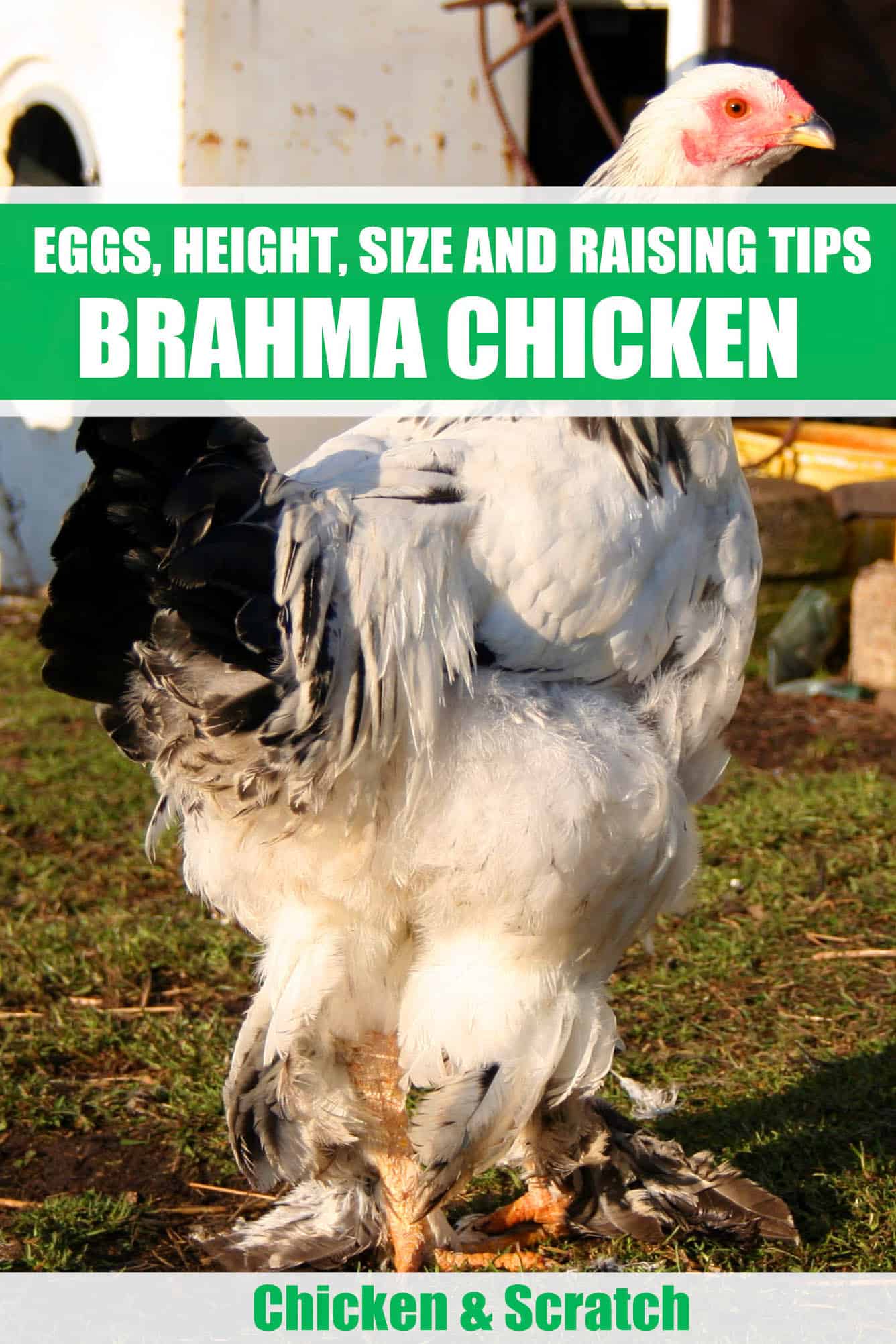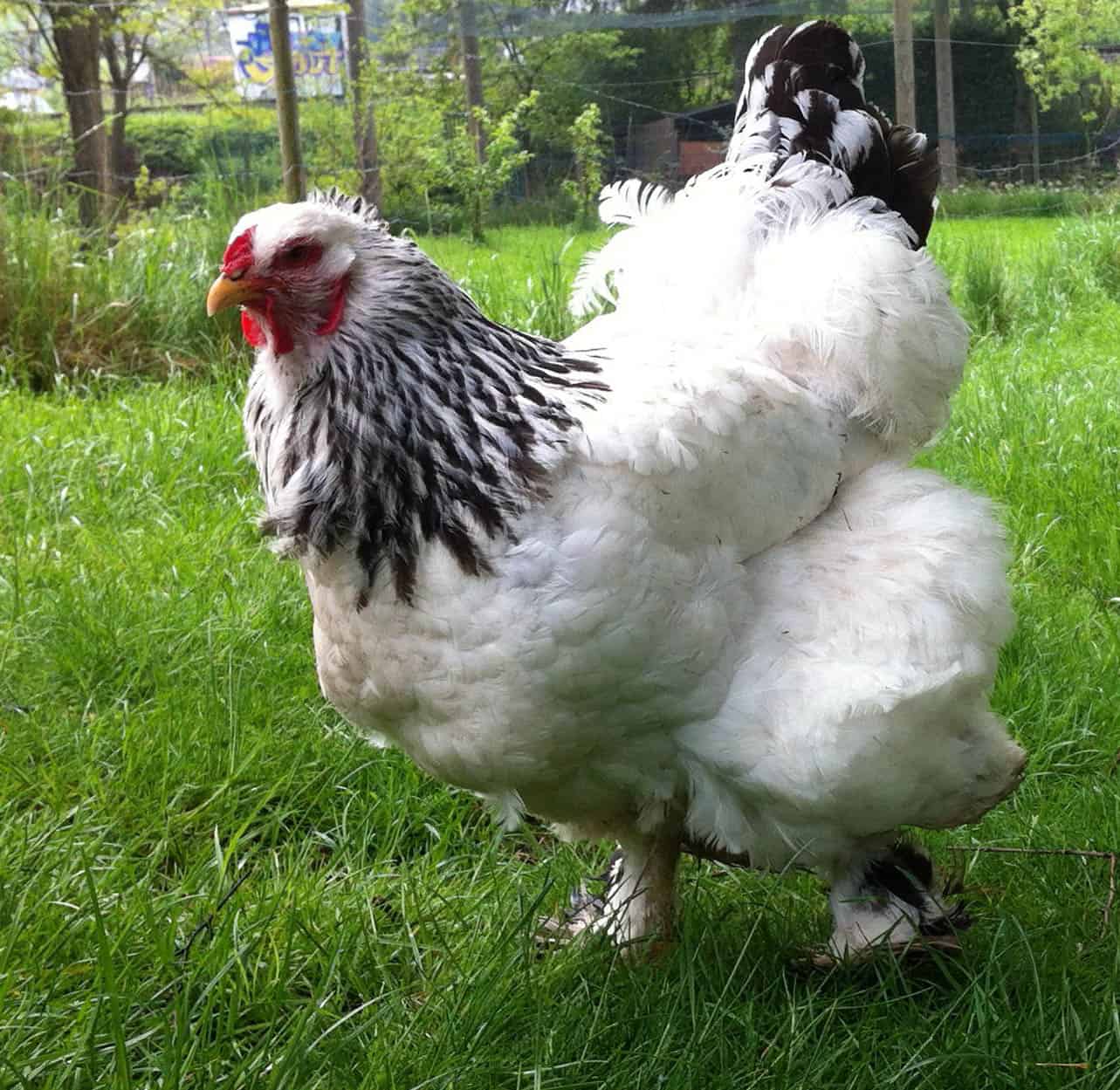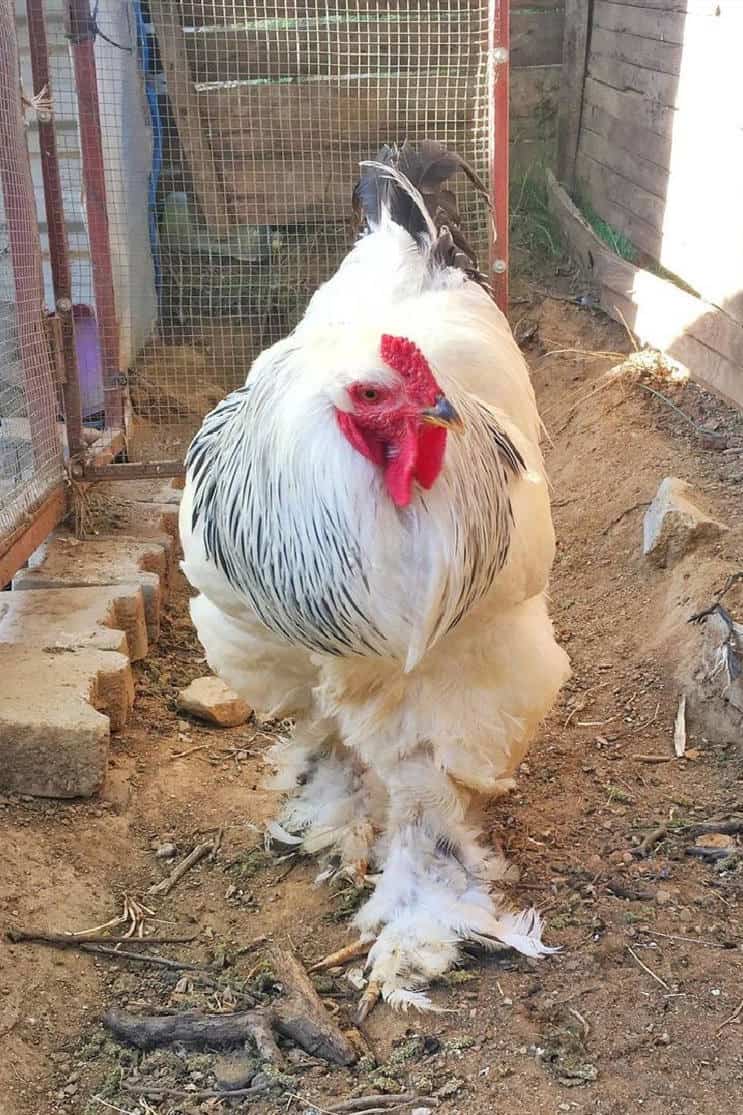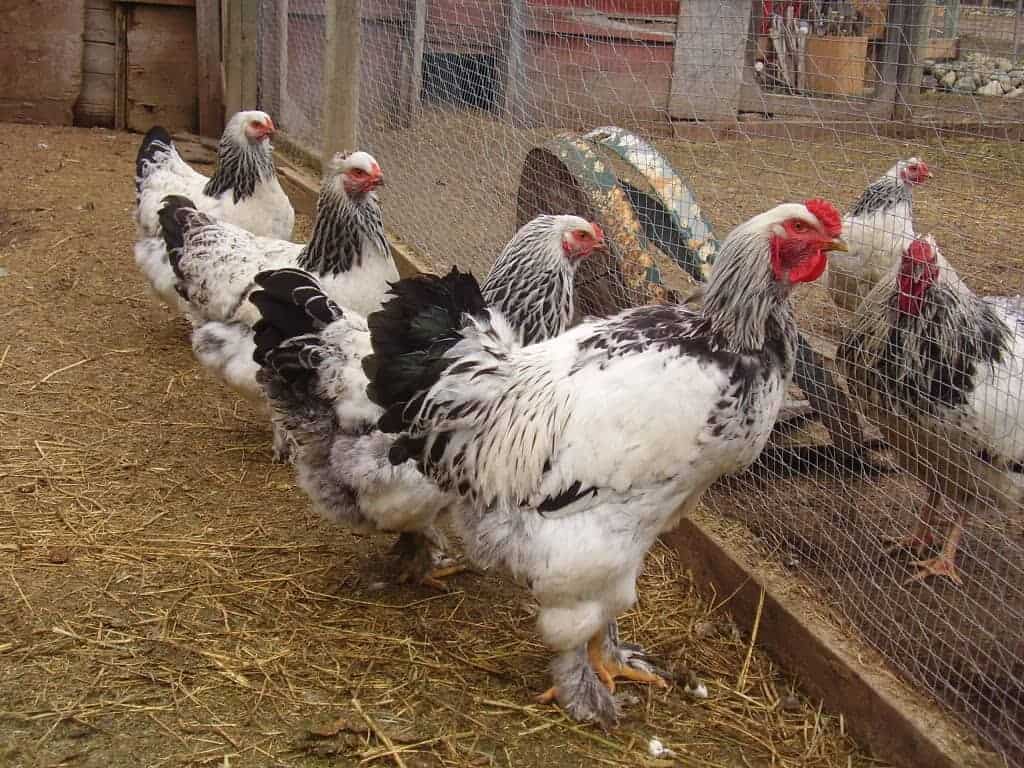If you’re looking for a docile, sweet-natured breed of chicken to raise, the Brahma just might be the right choice for you. This breed, often called the “King of All Poultry,” can be raised for eggs or meat, although the Brahma’s relaxed temperament makes it the perfect backyard pet, too.

Brahma Chicken Overview
| Size | Large |
| Body Shape | Broad
Compact |
| Country of Origin | United States |
| Weight | Rooster: 9 to 12 pounds (4 to 5.4 kg)
Hen: 6 to 10 pounds (2.7 to 4.1 kg) |
| Lifespan | 5 to 8 years |
| Temperament | Docile, Calm, and Friendly |
| Color | Light
Dark Buff |
| Rarity | Common |
| Breed Type | Dual-purpose
Ornamental |
| Best suited for | Families
Individuals Backyard farmers |
The Brahma has left an invaluable impression on the ever-growing chicken industry. While not famous for laying prolific, this versatile breed remains noted for its impressive weight and size – roosters pushing for more than five kilograms! Along with its large meat produce, it’s also become well regarded in show bird circles due to its bold and big feathers along the legs, giving it an incredibly majestic appearance.
Breeders have used Brahma’s genetics to produce hybrid chickens that offer everything from ornamental appeal to dual-purpose breeds. Keeping backyard this breed is now an increasingly popular and affordable option as they’re pretty calm and friendly. The portfolio of characteristics offered by the strong-bodied Brahma has enabled it to become a pivotal breed in both the professional and leisurely farming industry.
The Storied History of the Brahma

Few breeds of chicken have a history as remarkable as that of the Brahma. Their history is controversial, but the breed came to the United States from birds imported from Shanghai, China; the Cochin breed.
When compared, Cochins and Brahmas look strikingly similar–both are large with feathered legs, and both breeds are very docile. However, Cochins have a single comb, while the Brahma has a pea comb.
After its development, the Brahma received significant positive press in 1852. A Brahma breeder named George Burnham sent nine Brahmas to England’s Queen Victoria as a gift. The gift was offered to promote the breed, and it worked–the price for a pair increased nearly tenfold, from $12-$15 to $100-$150.
Until the early 1900s, the Brahma was one of the most commonly raised birds for meat in the United States. Since Brahmas are large, they routinely weigh 10 pounds or more–they were an economical choice, and just one could feed a family.
However, as faster-developing production chickens rose to prominence, Brahmas were replaced as America’s most popular meat bird. Today, this chicken is regarded as a “heritage breed” by the Livestock Conservancy, it’s a stark contrast to Brahma’s former popularity.
This organization identifies breeds at risk for extinction and encourages poultry keepers to raise them. But as more keepers discover this good-natured, versatile breed, Brahmas are slowly making a comeback.
The Breed Standard and Appearance
Breed Standard
Part of the appeal of Brahma chickens comes from their distinctive colors. The American Poultry Association recognizes three color varieties:
- Light–These birds are white with black feathering on their heads and tails. These black feathers usually appear to be laced with white. Light Brahmas are generally heavier than Dark Brahmas.
- Dark–These birds appear covered in an intricate, lace-like pattern. Feathers are primarily dark with white lacing. Roosters tend to have more white, especially on the hackles and saddle feathers.
- Buff–The Buff Brahma chickenlooks much like the Light Brahma, with the white feathers replaced by a soft golden color.
Appearance

Brahmas are also known for being huge chickens, and their ample feathering makes them appear even larger. This video of a Light Brahma rooster may help give you an idea of the sheer size of some of these birds. Roosters are often about 12 pounds, with hens weighing about 10.
These birds have an appearance that’s often described as both sturdy and proud. They appear to stand tall, with ample feathering on their thick legs. They have what’s known as a “beetle brow,” meaning their forehead reaches slightly over the eyes. It gives them the appearance of a prominent brow.
They also have pea combs. Since these combs are small and close to the head, they aren’t as susceptible to cold as breeds with larger combs. Combined with their dense feathering and thick down layer, this feature makes them very cold-resistant.
Their dense feathering means that Brahmas are often uncomfortable in hot, southern climates–they’re ideal for poultry keepers who frequently experience colder weather.
Personality and Temperament
In one word, the Brahma breed is often calm. These birds are easy keepers who enjoy interacting with people; many owners even describe them as huggable. Significantly if you raise your flock from when they’re chicks, Brahmas are likely to be interested in people, and they’re easy to handle.
Any chicken keeper knows that even small flocks can be filled with drama–some of the more active breeds tend to pick fights and reinforce their pecking order, sometimes with bloody results. However, Brahmas tolerate other birds, even those of different breeds.
They’re so peaceful that you can often keep multiple Brahma roosters in the same flock without incident. These birds also tolerate confinement reasonably well–they aren’t as active as many breeds, and they can be contained with relatively short fences. Of course, some of this is due to their size.
While they are muscular birds, their sheer weight makes it difficult for them to fly, and their quiet nature usually means they’re content to meander around a fenced yard.
Egg Laying of Brahma Chickens

| Egg Size | Large |
| Egg Color | Brown |
| Egg Laying | Good |
| Cold Hardy | Yes |
| Egg Production | 150 to 200 eggs |
| Cost per Chick | $2 -$5 |
Though they were once a popular meat breed, Brahmas are also known for their laying ability. In particular, they are prized for continuing to lay even in cold weather.
Brahma eggs are brown in color, but they are not particularly large for the size of the bird. Of course, you can’t expect a Brahma to match a true production breed in terms of eggs laid, but they lay very well for birds of their size.
And while it isn’t quite the same as egg laying, Brahmas have another advantage–they tend to be pretty broody. Hens will faithfully sit on their nests and are usually attentive mothers to chicks.
That said, if you intend to use them for their setting capabilities, you may need to protect the chicks when they’re tiny. Because Brahma hens are large, they may accidentally injure or kill chicks if they step on them.
Health Issues and Care

Generally speaking, the Brahma is an extraordinarily hardy breed of chicken. However, there are a few things you’ll need to pay attention to if you choose to add them to your flock.
Higher Risk of Frost Bite
The first issue is that of feathering on the feet. When clean, the Brahma’s additional feathering adds to their majestic look. However, because the feathering touches the ground, it’s prone to getting mud caked onto it.
If your birds end up walking through mud in warm weather, it isn’t likely to cause any issues. However, if the feet become muddy in winter, they need to be cleaned and monitored closely. If the feathers become wet or muddy and then freeze, it can cause frostbite, which is very painful for the chickens. In severe cases, it may even mean parts of their toes need to be surgically removed.
Overheating
The other issue is heating. Brahmas are birds who do best in cooler climates–their heavy layer of down and large body size means they have trouble keeping cool in the summers, especially if they’re kept in a warm environment.
To keep Brahmas healthy and comfortable in the summer, ensure they have access to shade and plenty of fresh, clean water. If you only have one or two and have space in your home, you can occasionally bring them inside for a few hours to give them a break from high heat.
Bumblefoot
Bumblefoot can be a common problem amongst Brahma chickens because of their size and weight. The bacteria enter through an irritated or injured foot pad, leading to infection. To prevent bumblefoot it is important that you inspect your chicken’s feet regularly and make sure they live in clean, comfortable conditions.
4 Tips for Raising Your Brahmas

As chicken breeds go, Brahmas are relatively easy to raise. The following tips will help you create the optimal environment for your new flock:
1. Spend Time With Them–Especially Early On.
Most Brahma owners describe their birds as being very friendly. If you want to keep your birds as pets, spend time with them, especially when young.
Frequently handling and talking to chicks helps them get used to you and learn that you aren’t a threat. With time, your Brahmas will likely eat out of your hand or even come up to you to let you pick them up.
2. Offer a Secure Coop With Plenty of Space.
With any breed of chicken, it’s important to give them a chicken coop that protects them from predators. If your coop has an attached run, ensure you can shut your chickens into the house portion at night–this adds extra protection from predators.
When you purchase or build a coop for Brahmas, make sure they will have extra space to walk around. Commercial coops often are advertised with an estimate of how many birds they can hold. Since Brahmas are larger than most breeds, you may want to reduce this estimate to ensure your chickens don’t feel crowded.
3. Be Sure to Keep the Coop Clean.
Since the feathering on their legs can quickly become dirty, regularly clean and sanitize your coop. A clean coop also helps keep your birds healthier and happier.
Keeping the coop clean is essential for Brahma chickens to remain healthy. Coops should be kept free from excess moisture, food scraps, debris, and waste materials which may cause a variety of bacterial or fungal diseases in chickens as well as parasites such as lice and mites. Droppings from other animals should also be scooped out regularly to keep them away from their leg feathers.
As we stated, due to the feathers on the chicken’s foot, they can be prime candidates for bumblefoot infection. Fortunately, cleaning and maintaining a clean environment regularly will keep this nasty disease from your Brahma chickens.
4. Give Them Space to Roam.
Brahmas are slower-moving chickens than most, but that doesn’t mean they don’t appreciate room to explore and forage. If you can’t let your birds be free-range most of the time, consider a coop with an attached run.
A covered run is ideal since it protects them from sun and rain. If your birds will be outside in the heat, be especially careful to ensure they have access to water and shade.
Summary
Whether you want a flock of reliable winter layers or a few backyard pets, the Brahma is an excellent choice. These people-oriented birds are quiet, easy to contain, and peaceful, and they coexist easily with other breeds, too. If you’re looking for a low-maintenance flock, a few Brahmas (or many!) can add joy to your life.

Joseph Hudson has been raising chickens for over 15 years. In 2018, he completed the Agriculture & Natural Resources program at Mt. San Antonio College. He currently raises over 1400 chickens on his 7.5-hectare farm. He keeps sharing his experience on raising healthy and happy chickens on Chicken Scratch The Foundry.







I am the proud keeper of three Brahma’s (one of each color) and although I have 20 other chickens which all vary in breed – these are without a doubt my sweetest and most loving birds. They absolutely love attention and follow me everywhere. They are extremely smart and when they run across the yard to greet you – you will never tire of the hilarity that ensues. The feathered feet paired with a unique gait will have you reaching for your camera phone or crouching down with your arms open for a big hug from your fluffy, feathered companion. They come running from anywhere to greet you and they all know their names and are as responsive as any of my dogs. They are so docile and good natured in spirit. My most difficult issue with my girls is only the fact that some of my more dominant breeds can sometimes send them running, especially when I am feeding them. I feed my brahma’s separately to avoid any aggressive behavior towards them which really helps. These are genuinely the kindest birds I have encountered and I highly recommend them for anyone looking for a companion and not just a chicken who provides eggs. They bring so much joy and love under all those feathers – you will want an entire flock. I hope you experience these amazing creatures for yourself. Just prepare to have your heart stolen by these fluffy angels! 😊♥️
Please this is my contact and I will want to have them, can you help me?
We just built and starting a flock 3 Bramas they are very friendly 3 week old one already runs to Bride and let’s her hold and pet were very excited
I just started a flock of 2 While Brahmas cock and a hen which were hatched 17th June 2022 now about 6 months old. Yet to start mating. At what Age will they start mating and laying?
I am eager to see them start hatching Chicks.
I have 3 buff brahmas chicks. The only thing information provided here is very valuable to me. Thanks.
I’m a first-time flock owner and have 1 light brahama and 8 other breeds. “Miss Daisy” comes running to leap onto my head or shoulders every time I get close enough to the ground. She is absolutely a cuddler and my favorite sweet girl. My chicks are only 10 weeks old and I didn’t realize how big the Brahamas get, so I’m looking forward to watching that happen!
(She also loves to be sung to at night. That’s right. I’m a grown-a$$ professional woman singing to chickens every dusk. Covid did weird things to all of us.)
We have 31 chickens, 4 of them are Buff Brahmas and they are the most well behaved and easiest to put to bed EVERY evening and we didn’t spend alot of time with them when they were babies, they are 3 years old now and we love them! We also have 1 Light Brahma pullet,she’s a nervous kid because the others have and occasionally still pick on her,she’s about 18 wks old and starting to pick back and coming closer to us. Hopefully she’ll come around also. Our 4 “Brahma Chicks” eggs are not much for size maybe that’s normal?